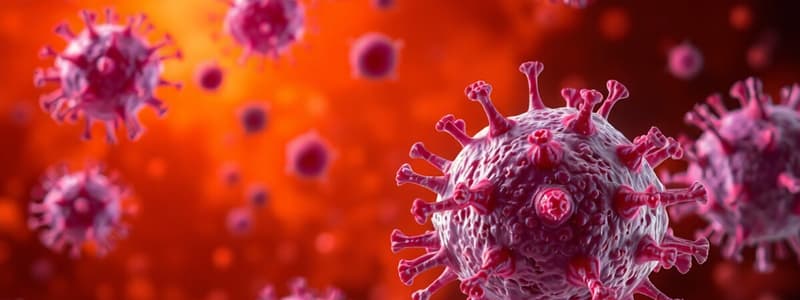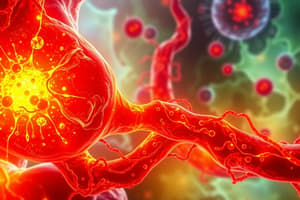Podcast
Questions and Answers
What structural change occurs in the microcirculation during acute inflammation?
What structural change occurs in the microcirculation during acute inflammation?
- Increased vascular permeability (correct)
- Thickening of vessel walls
- Decreased capillary size
- Vasoconstriction
Which of the following is NOT a classical sign of inflammation?
Which of the following is NOT a classical sign of inflammation?
- Redness
- Heat
- Swelling
- Fatigue (correct)
What mechanism primarily causes increased vascular permeability during acute inflammation?
What mechanism primarily causes increased vascular permeability during acute inflammation?
- Inhibition of inflammation mediators
- Endothelial cell growth
- Endothelial cell contraction and retraction (correct)
- Blood vessel thickening
What effect does increased vascular permeability have on blood viscosity?
What effect does increased vascular permeability have on blood viscosity?
Which component of acute inflammation is characterized by alterations in vessel caliber?
Which component of acute inflammation is characterized by alterations in vessel caliber?
What is the main role of endothelial cells in the vascular response during acute inflammation?
What is the main role of endothelial cells in the vascular response during acute inflammation?
Which of the following stimuli is likely to trigger acute inflammation?
Which of the following stimuli is likely to trigger acute inflammation?
What is the primary consequence of genetic defects in leukocyte function?
What is the primary consequence of genetic defects in leukocyte function?
Which condition is associated with defects in leukocyte adhesion?
Which condition is associated with defects in leukocyte adhesion?
What type of defect is linked to chemotherapy and radiation exposure?
What type of defect is linked to chemotherapy and radiation exposure?
What role do chemical mediators play in the inflammatory process?
What role do chemical mediators play in the inflammatory process?
Which of the following best describes cell-derived mediators?
Which of the following best describes cell-derived mediators?
What initiates the production of chemical mediators during inflammation?
What initiates the production of chemical mediators during inflammation?
Which of the following chemical mediators can influence the release of additional mediators?
Which of the following chemical mediators can influence the release of additional mediators?
What is a common effect of acquired defects in leukocytes?
What is a common effect of acquired defects in leukocytes?
What is the main effect of histamine and serotonin as vasoactive amines?
What is the main effect of histamine and serotonin as vasoactive amines?
Cytokines such as TNF and IL-1 are mainly involved in which aspect of inflammation?
Cytokines such as TNF and IL-1 are mainly involved in which aspect of inflammation?
Which of the following best describes inflammation?
Which of the following best describes inflammation?
Which of the following is NOT a role of reactive oxygen species in inflammation?
Which of the following is NOT a role of reactive oxygen species in inflammation?
What are the five Rs of the inflammatory response?
What are the five Rs of the inflammatory response?
Which type of mediator is primarily responsible for increasing vascular permeability during inflammation?
Which type of mediator is primarily responsible for increasing vascular permeability during inflammation?
What beneficial effect does inflammatory exudate have in the context of acute inflammation?
What beneficial effect does inflammatory exudate have in the context of acute inflammation?
What role do chemical mediators play in the inflammatory response?
What role do chemical mediators play in the inflammatory response?
What is granulomatous inflammation primarily characterized by?
What is granulomatous inflammation primarily characterized by?
Which of the following is a product of the kinin system that contributes to inflammatory pain?
Which of the following is a product of the kinin system that contributes to inflammatory pain?
Which of the following can result from inappropriate or prolonged inflammation?
Which of the following can result from inappropriate or prolonged inflammation?
Which mediator is primarily involved in the complementary system's role during inflammation?
Which mediator is primarily involved in the complementary system's role during inflammation?
The role of nitric oxide in inflammation includes which of the following?
The role of nitric oxide in inflammation includes which of the following?
What happens during the recruitment phase of inflammation?
What happens during the recruitment phase of inflammation?
Which of the following factors might affect the healing process after inflammation?
Which of the following factors might affect the healing process after inflammation?
When does inflammation typically terminate?
When does inflammation typically terminate?
What is the primary role of CD31 (PECAM-1) during leukocyte transmigration?
What is the primary role of CD31 (PECAM-1) during leukocyte transmigration?
Which mechanism is NOT involved in the modulation of adhesion molecules during leukocyte rolling and adhesion?
Which mechanism is NOT involved in the modulation of adhesion molecules during leukocyte rolling and adhesion?
What characterizes the process of chemotaxis in leukocytes?
What characterizes the process of chemotaxis in leukocytes?
Which of the following receptors on leukocytes is involved in recognizing microbial products?
Which of the following receptors on leukocytes is involved in recognizing microbial products?
What facilitates phagocytosis of microbes by neutrophils?
What facilitates phagocytosis of microbes by neutrophils?
What mechanism leads to the killing of microbes during phagocytosis?
What mechanism leads to the killing of microbes during phagocytosis?
Which of the following is a consequence of lysosomal enzymes leaking into tissue during phagocytosis?
Which of the following is a consequence of lysosomal enzymes leaking into tissue during phagocytosis?
Why do neutrophils dominate during acute inflammation?
Why do neutrophils dominate during acute inflammation?
Study Notes
Inflammation Definition
- Inflammation is the natural immune response of tissues and blood vessels to pathogenic insults.
- It is characterized by the movement of white blood cells and fluids from blood to the damaged site.
- Inflammation serves to neutralize and eliminate the cause of tissue injury, including foreign bodies, microorganisms, and antigens.
Objectives Of The Coarse
- The student should be able to identify and understand the inflammatory process as a part of the body's defense mechanism.
- Students should be able to differentiate and explain different types of inflammation based on their underlying mechanisms.
- Comprehending the function and mechanism of chemical mediators in the inflammatory response.
- Students will develop a comprehensive understanding of granulomatous inflammation, its causes, and microscopic features.
- The course aims to equip students with knowledge of the healing process and factors influencing it.
Signs Of Inflammation
- The five cardinal signs of acute inflammation include:
- Redness (Rubor): Caused by increased blood flow to the area.
- Swelling (Tumor): Accumulation of fluid in the interstitial space.
- Heat (Calor): Increased blood flow brings warm blood to the area.
- Pain (Dolor): Mediated by release of chemical mediators, stimulating nerve endings.
- Loss of function (Functio laesa): Due to pain and swelling, limiting the area's movement.
Causes Of Acute Inflammation
- Infections: Bacteria, viruses, fungi, and parasites.
- Trauma: Physical injury, burns, and surgical procedures.
- Foreign bodies: Splinters, sutures, and other materials.
- Immune reactions: Hypersensitivity reactions (allergies) and autoimmune diseases.
Components of Acute Inflammation
- Vascular response:
- Vasodilation: Increases blood flow, leading to redness and heat.
- Increased vascular permeability: Allows fluid and proteins to leak into the interstitial space, causing swelling.
- Cellular response:
- Recruitment of leukocytes: These cells migrate to the site of inflammation to "clean up" the area.
- Phagocytosis of the injurious agent: Leukocytes engulf and destroy pathogens, cellular debris, and foreign bodies.
Steps of The Inflammatory Response
- Recognition: The body's immune cells identify the injurious agent.
- Recruitment: Leukocytes, primarily neutrophils, are drawn to the site of inflammation.
- Removal: Leukocytes engulf and destroy the injurious agent.
- Regulation: The inflammatory response is controlled to prevent excessive damage.
- Resolution: The tissue is repaired and returns to its normal state.
Chemical Mediators Of Acute Inflammation
- These chemical messengers play a key role in the inflammatory process.
- Cell-derived mediators: Produced locally by cells at the site of inflammation (e.g., histamine, prostaglandins, cytokines).
- Plasma protein derived mediators: Synthesized by the liver and activated during inflammation (e.g., complement system, kinin system, clotting system).
Effects of Chemical Mediators
- They trigger a cascade of events to initiate and regulate inflammation.
- They bind to specific receptors on target cells, initiating a series of responses.
- Mediators can stimulate the release of other mediators from the target cells (secondary mediators).
- They are short-lived and controlled to prevent excessive inflammation.
Beneficial Effects of Acute Inflammatory Exudate
- Dilution of toxins: Helps to neutralize harmful substances.
- Protective antibodies: Exudate carries antibodies to the site of infection.
- Fibrin formation: Exudate helps form clots to limit the spread of infection.
- Plasma mediator system: Exudate delivers important mediators to the site of injury.
- Cell nutrition: Exudate delivers nutrients to cells involved in repair.
- Promotion of immunity: Exudate aids in the presentation of antigens to the immune system.
Defects in Leukocytes Functions
- Genetic defects: Affect the function of leukocytes and increase susceptibility to infection.
- Leukocyte adhesion defects: Impaired ability to adhere to the endothelial lining of blood vessels, preventing them from reaching the site of inflammation.
- Phagolysosome function defects: Impaired ability to engulf and destroy pathogens.
- Microbicidal activity defects: Reduced ability to kill microbes.
- Acquired defects: Acquired conditions that impair leukocyte function.
- Bone marrow suppression: Reduced production of leukocytes, leading to a compromised immune system.
- Chemotaxis defects: Reduced ability of leukocytes to migrate to the site of inflammation.
- Adhesion defects: Impaired ability of leukocytes to adhere to the endothelial lining of blood vessels.
- Phagocytosis and microbicidal activity defects: Impaired ability to engulf and destroy pathogens.
Major Cell-Derived Mediators of Inflammation
- Vasoactive amines:
- Histamine: Released from mast cells, causes vasodilation and increased vascular permeability.
- Serotonin: Released from platelets, contributes to vasodilation and increased vascular permeability.
- Arachidonic acid metabolites:
- Prostaglandins: Play a role in vasodilation, pain, and fever.
- Leukotrienes: Contribute to chemotaxis, vascular permeability, and bronchoconstriction.
- Cytokines:
- TNF (Tumor Necrosis Factor): Mediates inflammation, fever, and cell death.
- IL-1 (Interleukin-1): Mediates inflammation, fever, and cell death.
- Chemokines: Attract leukocytes to the site of inflammation.
- Reactive oxygen species (ROS):
- Play a role in microbial killing and tissue injury.
- Nitric oxide (NO):
- Causes vasodilation and plays a role in microbial killing.
- Lysosomal enzymes:
- Released from leukocytes, contribute to microbial killing and tissue damage.
- Platelet activating factor (PAF): Triggers platelet aggregation, vasodilation, and increased vascular permeability.
Role of Mediators in Specific Reactions Of Inflammation
- Vasodilation: Prostaglandins, nitric oxide, and histamine.
- Increased vascular permeability: Vasoactive amines, complement components (C3a and C5a), bradykinin, and leukotrienes.
- Chemotaxis and leukocyte activation: Leukotriene B4, C5a, IL-1, TNF, chemokines.
- Fever: IL-1, TNF, and prostaglandins.
- Pain: Prostaglandins and bradykinin.
- Tissue damage: Lysosomal enzymes, reactive oxygen species, and nitric oxide.
Studying That Suits You
Use AI to generate personalized quizzes and flashcards to suit your learning preferences.
Related Documents
Description
This quiz covers the fundamental concepts of inflammation as a critical immune response. It focuses on the mechanisms involved, types of inflammation, and the role of chemical mediators in the healing process. Students will assess their understanding of granulomatous inflammation and its characteristics.



